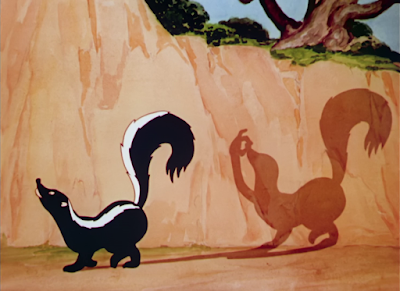You’ve seen all kinds of lists of the best cartoons of all time.
They’re all bunk. What do people like Jerry Beck know? He’s written, what, maybe one or two books? Anyone can write books. Type one word and then the next. Big deal.
It behooves (look it up) us to present to you the REAL top five cartoon series of all time. Every single one of them puts the “Golden” in “Golden Age.” Drum roll, please, professor.
 5. LITTLE AUDREY
5. LITTLE AUDREY
Fish, mammy housekeepers, truant officers, she loves them all. Her mixed chorus theme songsters remind us she says “Save for a rainy day.” You’ve heard her say that in many a cartoon.
Then there’s her cheering, cheerful laughter. We can’t hear it enough. Don’t worry, Little Audrey. We’re laughing WITH you, not at you.
 4. COOL CAT
4. COOL CAT
You know when you see a swirling line and hear Bill Lava’s lush score to open a cartoon instead of concentric circles, you’re in for top-quality entertainment. Pink Panther? A pale imitation of Cool Cat. Pink didn’t have that groovy ‘60s far-out-ness.
Larry Storch forgot he voiced the character? A minor slip.
 3. DAFFY AND SPEEDY
3. DAFFY AND SPEEDY
A perfect pairing, far superior to Laurel and Hardy, Felix and Oscar, Gilligan and the Skipper. Lightweights, all. Everyone knows ducks chase mice, especially gringo ducks.
That old “Woo-hoo”-ing Daffy? Unfunny and old hat. Better make that “old sombrero.” This is a Daffy for today’s generation, not Bob Clampett’s (and what did he do after Warner Bros., anyways?).
The only thing that could improve this beloved twosome is if they were directed by Tom Palmer.
 2. THE BEARY FAMILY
2. THE BEARY FAMILY
Who could tire of the screamingly-amusing antics of Charlie Beary? Fixing something himself to save money? No one’s ever done that in a comedy. Mother-in-law coming over? Fresh and unique entertainment.
Add the superior directorial touches of Paul J. Smith, and full, symphonic orchestrations of Walter Greene, and you have non-stop hilarity. We’re talking “Laffs” with two “f”s.
Before we get to Number One, let’s give you our Honorable Mentions:
 BUDDY
BUDDY
What was Leon Schlesinger thinking, replacing this charmer with a stuttering pig and a smarty-pants wabbit? What does someone wearing a carnation know about screen comedy? Nothing, that’s what. Saying “That’s all, folks” to this series shows Schlesinger is no buddy to us all.
 HAM AND HATTIE
HAM AND HATTIE
UPA was known the world over for their giggle-fests. This series featured characters that were, well, I’m not quite sure what they were doing. But they were loveable and cuddly. UPA cartoons are worshipped for their painstakingly-crafted, rollicking, slapstick comedy.
 AMOS ‘N’ ANDY
AMOS ‘N’ ANDY
Van Beuren’s well-drawn, sensitive portrayal of two white guys as African-Americans has won over fans of ethnic humour for generations. You won’t be “regusted” watching this series, which unfortunately ended after its stars checked and double-checked this fine-grained artwork, got into a Fresh-Air Taxi Cab and quit.
And now, the Greatest of All Time:
 1. LUNO
1. LUNO
Terrytoons had a challenge, trying to overcome such unpopular “Woolworth” series as Mighty Mouse and Heckle and Jeckle. The retired Paul Terry, counting his money while living in an exclusive gentlemen’s club in New Rochelle, must have been overjoyed with this crowning glory to his studio’s reputation.
Luno features the thrilling adventures of a flying horse, an original idea if ever there was one. Yes, Casper had a flying horse but that was a GHOST horse. This is different.
The studio wisely did not restrict these oft-mistaken-for-Disney cartoons to television alone. They were made available to eager theatre owners for the world to see. Their witty writing alone would make the denizens of the Algonquin Round Table (look it up) lower their collective heads in crimson-faced shame.
Oh, one other thing.
APRIL FOOL!!
Actually, we do have one other thing.
Not everyone reading this blog enjoys exactly the same cartoons or any other kind of entertainment. Yet some people go ballistic if someone dislikes (or make fun of) something they really like. Oh, they’re killing a childhood! One that ended years ago.
Here’s the deal. Watch cartoons you like. Don’t waste time getting worked up if someone disagrees. They’re just cartoons. There are more important things in life that should concern you. You’ll be healthier and happier.
And Luno still sucks.
























































